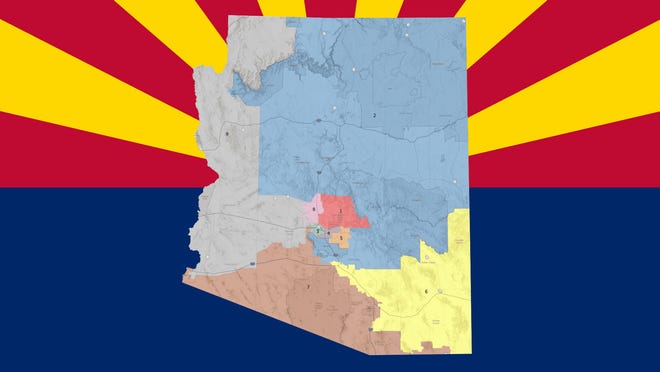AZ Republicans come out ahead in seats for Legislature, Congress as redistricting panel approves maps

Arizona’s representation in the U.S. House of Representatives is likely to shift to a Republican majority after the Arizona Independent Redistricting Commission unanimously approved a transformative, GOP-leaning congressional map Wednesday.
The commissioners weren’t able to stay unified in the end, however.
After a full day of discussion and arguments, the commissioners also approved a Republican-leaning but balanced map for districts in the Legislature in a contentious 3-2 vote.
Arizona’s current congressional delegation is made up of five Democrats and four Republicans. The new map, should it withstand legal challenges, favors Republicans in five — and possibly six — of the state’s nine districts.
Yet the five-member commission approved the map with a 5-0 vote, which Republican Commissioner Douglas York attributed to the effort of independent Chair Erika Neuberg, who called the map a “sweet spot for all sides to be well-positioned.”
She acknowledged that “each side is deeply disappointed by aspects of this map.”
View the map: Arizona redistricting panel approves new map
Registered Republicans make up the highest number of voters in the state, followed by independents and then Democrats.
Arizona and all other states redraw their political maps once every 10 years based on the census. Voters created the independent redistricting system with a ballot initiative in 2000, hoping to take politics out of the map-drawing process.
How unanimous vote came together
During final deliberations of the congressional map Tuesday, Democratic commissioners Shereen Lerner and Derrick Watchman voiced strong concern about the map, then said after a long day of making minor changes that little had changed. But on Wednesday, Lerner said the map was indeed improved.
“We’ve made a lot of progress over the course of these months as we’ve moved forward,” said Lerner, who seconded Neuberg’s motion to approve the map. “There’s some good in this map as well, and there were some things that really could have done a better job.”
Expressing disappointment that the map wasn’t as competitive as Democrats had hoped, the political situation could nevertheless “evolve” over the next 10 years, adding that the state is in a “different place” now than it was 10 years ago.
In 2010, Arizona had five Republicans and three Democrats in eight districts. The state added a ninth district after the 2010 census but did not gain a 10th congressional seat in 2020, as many had expected.

“We listened to a lot of folks” during the public hearings, said Republican Commissioner Douglas York. “We tried hard to incorporate the Latino Coalition and Native Americans’ request … . I’m very pleased to provide a fifth vote for this map.”
York gave credit to Neuberg for the unanimous decision.
“She worked to make us work to get to the center,” he said. “And neither side was happy so therefore she was successful.”
Neuberg, a Chandler psychologist, was criticized throughout the process by Democrats as potentially not independent. She said from the start of the process last summer that she hoped to achieve a consensus on the maps rather than preside as tiebreaker over a bitter, partisan process.
The 2011 redistricting process was far more contentious, and the independent chair then, Colleen Mathis, was vilified by Republicans and temporarily booted out of her position until the state Supreme Court reinstated her.
Map for Legislature divides panel
The approved maps for districts in the Legislature split 13-12 for Republicans and contain five highly competitive districts. The Arizona Legislature has 30 districts in total.
While four of five of those districts lean Republican, they’re all so competitive that it’s possible for a candidate of either party to win. If Democrats can win in four of the five competitive districts, they could flip at least one chamber. Three flips would create a power-sharing situation.
Currently, the Senate has a 16-14 advantage for Republicans, while the House has a similar GOP advantage of 31-29.
The divided vote ran counter to Neuberg’s goal to achieve consensus on the maps and combined with previous 3-2 votes advancing draft maps that Democrats didn’t like, likely open her up to more criticism about her independence.
Watchman, who made it his focus to advance the desires of the state’s Native American communities, said he and Navajo Nation leaders were satisfied with changes suggested by the Republican commissioners that boosted the number of Native Americans of voting age in Legislative District 6.
The largest district on the map, it takes up a massive swatch of north-central and northeast Arizona and encompasses most of the state’s tribal communities. The changes put some White Mountain communities into Legislative District 7.
“This is really the spirit of compromise,” Neuberg said after Watchman said he supported the district.
North Phoenix district stirs debate
Still, some obstacles remained before the final vote.
Lerner and Watchman began the legislative debate by drawing a firm line in the sand: They would not compromise on draft Legislative District 2, which Lerner said was changed for no good reason Monday into a Republican-leaning highly competitive district, when in previous maps it had been highly competitive and Democratic-leaning.
The district is cross-shaped and in the north Phoenix, going from north of the North Mountain and Shaw Butte preserves to the Cave Buttes Recreation Area, and from 43rd Avenue to roughly State Route 51.
York and Mehl suggested that if the commission wants to revisit that district, they had districts they wanted to revisit, too, including the extremely competitive GOP-leaning Legislative District 13.
The commission defines competitiveness as a measure of Republican and Democratic votes in key statewide races over the past three election cycles, plus the number of party wins for those races.
Wednesday’s argument boiled down to the fact that the latest draft for that area had a competitiveness factor of 3.8%, with Republicans more likely to win and Lerner wanted it at 1.3% with Democrats slightly more likely to win. Anything below the 4% mark is considered “highly competitive.”
Arguments grew slightly heated following a lunch break, with Commissioners Mehl and Lerner occasionally talking over each other. Mehl raised his voice to interrupt Lerner, saying that while LD2 did change on Monday, it was because of a multitude of small changes in other districts that the commission had wanted.
Lerner said the changes were targeted to “remove Democrats and add Republicans into this district.”
Commissioners take final votes
Late in the afternoon, Neuberg seemed to have had enough of the discussion and said she was ready to vote on the legislative map. At that point, Lerner mentioned that she had “evidence” of possible map manipulation by a commissioner who she said took into account the home address of the sitting legislator, which is illegal. The commission went into executive session for about a half-hour but didn’t address Lerner’s accusation when they reconvened.
Neuberg said she wanted to give commissioners “one last chance” to fine-tune the district in question. Lerner said her four proposals for changes to the district already were rejected. Neuberg said she saw nothing “compelling” and would move forward with a vote.
Watchman voted no, Lerner passed on her vote while Mehl and York voted yes.
“I think this map is a terrific map for the state of Arizona,” Mehl said. “Very pleased we were able to end up with a win-win.”
York ran through a list of the new districts and their benefits, mentioning that Voting Rights Act districts with majority-minority voters have a good chance of electing their candidates of choice.
Neuberg, before voting, said the maps “will further encourage elected leaders to pay attention to their constituents … . Regions are relatively balanced and taken care of.” As for competitiveness, the “toss-ups” mean that Arizona’s political future is not set in stone.
“We’ve worked hard together to make the best decisions,” she said. “And I vote yes.”
Lerner then addressed the commission, saying the partisanship surprised her. One example, she said, was how “Yavapai County became sacred in our deliberations” despite members of the public testifying that it would be better to split it than keep it intact.
As Ann Heitland, chair of Coconino County Democratic Party, wrote in a Dec. 4 opinion column in The Arizona Republic, liberal-leaning Sedona is now “split between two safe Republican districts.”
Lerner voted no after her speech.
Neuberg said she remained “proud of the collective hard work” by the commission.
Criticism from Democratic groups grew after the divided vote.
Neuberg was “anything but fair,” according to Steve Gallardo, co-chair of the Latino Coalition for Fair Redistricting and a Maricopa County supervisor. With both the congressional and legislative maps leaning Republican, coalition members believe their wishes were ignored, he said.
“The process was rigged from the beginning,” Gallardo said. “We compromised a lot.”
The coalition met with Neuberg several times, offering a map that fit eight Latino-majority districts instead of seven, with increased competitiveness, but now it seems like “we were talking to the wall.”
“Anytime we don’t have a seat and are dependent on non-Latinos, we always get let down,” he said.
What happens next
Following a 2013 U.S. Supreme Court decision, the new congressional map doesn’t need an OK from the U.S. Department of Justice, as past maps have due to Arizona’s history of marginalizing minority voters.
Some administrative changes will still need to be made by the state’s 15 counties on the approved map; the commission will convene once more to make sure those changes truly are only administrative. Then the new map will be sent to the Secretary of State’s Office, where it will be certified and used for the 2022 election cycle.
Reach the reporter at rstern@arizonarepublic.com or 480-276-3237. Follow him on Twitter @raystern.

